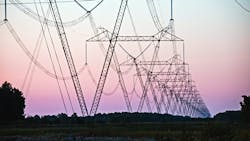SunZia Transmission Project Hits Snag Over Cultural Site Impacts
About two months into its construction, work on the SunZia transmission project has suspended across a 50-mile segment over concerns raised by Arizona Indigenous groups for the preservation of cultural sites.
Leaders of the Tohono O’odham Nation told the Interior Department that the Bureau of Land Management’s inventory of historic properties in the San Pedro Valley was incomplete and flawed, thus putting them at risk of damage.
The BLM plans to work to address these concerns “government-to-government” with the nation and ordered work suspended in the meantime. The San Carlos Apache Tribe, Zuni Pueblo and some archeologists have added their concerns about preserving historic sites from any potential construction impacts at SunZia.
SunZia has been in the permitting, approvals and permissions process for about 15 years. Construction time, if all goes well, should take about three years.
Project partner Pattern Energy, which is investing about $8 billion into the project, said the company has always worked to address Tribal concerns and will continue to do so.
The project is a 550-mile ± 525 kV HVDC transmission line, which can transport as much as 4,500 MW of renewable power across Western states, between central New Mexico, south-central Arizona and Southern California.
Hitachi Energy’s HVDC Light technology will transfer and integrate vast volumes of wind power over more than 885 kilometers (550 miles) into the regional power grid. The project is currently valued at about $10 billion, according to reports.
Thirty percent of the total project route is made up of federal lands administered by the BLM, Bureau of Reclamation, and U.S. Fish and Wildlife Service. SunZia Transmission has also signed right of way agreements with the New Mexico State Land Office and the Arizona State Land Department to support education and other public institutions.
Hitachi Energy has already started designing and engineering the two HVDC Light converter stations, one at either end of the link. Quanta Services is partnering with Hitachi Energy to provide a turnkey project solution for the SunZia project, including managing the HVDC construction and building installation at the associated project sites.
Hitachi Energy will also supply alternating current (AC) chopper technology to restore power if the power flow on the DC line or in the AC grid in Arizona is temporarily interrupted by weather or other contingency events.
"The SunZia Transmission Project will accelerate our nation's transition to a clean energy economy by unlocking renewable resources, creating jobs, lowering costs, and boosting local economies," said Secretary of the Interior Deb Haaland. "Through historic investments from President Biden's Investing in America agenda, the Interior Department is helping build modern, resilient climate infrastructure that protects our communities from the worsening impacts of climate change."
The permitted route originates at a planned substation in Torrance County, New Mexico, and terminates at the existing Pinal Central Substation in Pinal County, Arizona. The project traverses Grant, Hidalgo, Lincoln, Luna, Sierra, Socorro, Torrance and Valencia counties in New Mexico and Cochise, Graham, Greenlee, Pima and Pinal counties in Arizona, according to the Energy Department.
Pattern Energy’s 3,500 MW SunZia Wind project across Torrance, Lincoln, and San Miguel Counties in New Mexico will be constructed together with the transmission project, which will deliver clean power from the wind project.
According to a study conducted by Energy, Economic & Environment Consultants, both the SunZia Transmission and SunZia Wind projects are expected to generate $20.5 billion in total economic benefit.
The projects are also expected to generate $1.3 billion in fiscal impacts for governments, communities and schools through sales and use taxes, property taxes, community benefit payments and land payments to federal and state agencies.
According to project partners, SunZia Wind and Transmission Projects have worked closely with the public, BLM, landowners, ranchers and numerous wildlife conservation agencies such as the Audubon Society and Defenders of Wildlife, to foster productive dialogue about the environmental review of these projects, listen to concerns and recommendations, and incorporate feedback.
About the Author
Jeff Postelwait
Managing Editor
Jeff Postelwait is a writer and editor with a background in newspapers and online editing who has been writing about the electric utility industry since 2008. Jeff is senior editor for T&D World magazine and sits on the advisory board of the T&D World Conference and Exhibition. Utility Products, Power Engineering, Powergrid International and Electric Light & Power are some of the other publications in which Jeff's work has been featured. Jeff received his degree in journalism news editing from Oklahoma State University and currently operates out of Oregon.
